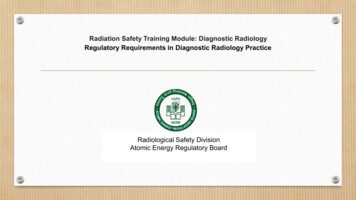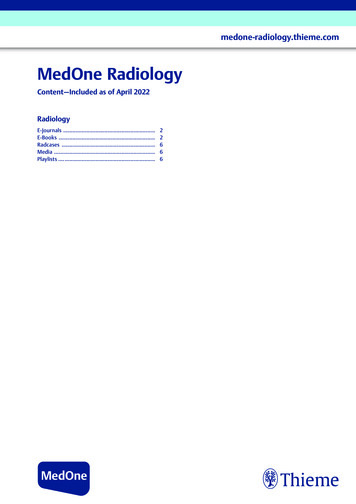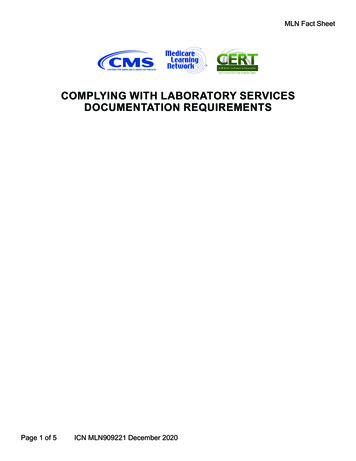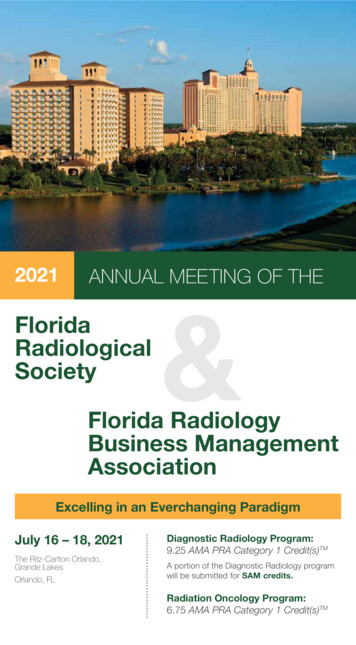
Transcription
Radiation Safety Training Module: Diagnostic RadiologyRegulatory Requirements in Diagnostic Radiology PracticeRadiological Safety DivisionAtomic Energy Regulatory Board
Content Expected questions to know after studying this lectureIntroductionRegulatory FrameworkAERB Safety Code No. AERB/RF-MED/SC-3 (Rev. 2)Summary/ Learning OutcomesExpected QuestionsReferences and sources for additional information
Expected questions to know after studying this lecture Which Government Rule is applicable for radiation safety in the country? Who is the competent Authority for ensuring radiation safety in the country? What is the qualification of RSO in diagnostic radiology user’s facility? What is the requirements for control room for CT & IR facilities? Understand the regulatory provisions for occupational radiation protection.
AIMThe Mission of AERB is to ensure theuse of ionizing radiation and nuclearenergy in India does not cause unduerisk to the health of people and theenvironment.”
WHAT IS REGULATION ? Regulation refers to “controlling human or societal behavior by rulesor restrictions” Costs for some and benefits for others Efficient where the total benefits to some people exceed the totalcosts to others Regulatory agencies deal in regulation or rulemaking andenforcing rules and regulations for the benefit of the public at large
SYSTEM OF REGULATORY CONTROLIssued by Central GovernmentActPublished by AERBSafety Codes(Atomic Energy Act, 1962)Rules(Atomic Energy RadiationProtection) Rules, 2004)Notifications(Radiation SurveillanceProcedures for MedicalApplications of Radiation, 1989)Safety StandardsSafety GuidesSafety Manuals7
REGULATORY FRAMEWORK AERB was constituted in 1983 for carrying out the regulatory andsafety functions envisaged in the Atomic Energy Act, 1962. Main Functions of AERB- Safety assessment for granting licence- Regulatory Inspections- Development of regulatory safety documents
SAFETY CODE:Safety codes for each application/practice are identified on the basis of national andinternational practices. The requirements covered in Safety Code are mandatory in nature. Safety codes spell out requirements to be compiled by the licensee at all stages ofactivities of nuclear/radiation facilities. Safety assessment is based on satisfactory fulfilment of such requirements by the licenseefor granting licence by AERB.
AERB Safety Code No. AERB/RF-MED/SC-3 (Rev. 2)It contains seven sections and two gn Requirement for X-ray EquipmentRegulatory Requirements for Manufacturers of X-ray Equipment and X-ray TubesRegulatory Requirements for Suppliers of X-ray Equipment and X-ray TubesRegulatory Requirements in Use of X-ray EquipmentResponsibilities of Employer, Licensee, RSO and Radiation WorkerRequirements for Occupational Radiation ProtectionAppendices:Appendix-IDesign Specifications for X-ray EquipmentAppendix-IIDesign Specifications for Radiation Protection Devices
Objective:This Safety Code is intended to govern radiation safety in design, manufacture, installation, operation anddecommissioning of diagnostic x-ray equipment for medical diagnostic purposes in order to:i.ensure that radiation workers and members of public are not exposed to radiation in excess of doselimits;ii. reduce radiation exposures below these limits to levels ALARA andiii. ensure that radiation exposures to patients are optimized.Scope:i.The Code stipulates radiological safety requirements for manufacturers, suppliers and users ofmedical diagnostic x-ray equipment.ii. This Code does not address the conventional safety and fire safety requirements of medical diagnosticx-ray equipment.iii. Safety Code also covers roles & responsibilities of personnel involved in handling of x-ray equipment.
AERB Safety Code No. AERB/RF/SC/MED-2 (Rev. 2) . The following x-ray equipment are covered in this Code: Radiography (Fixed, Mobile, Portable) Interventional Radiology, C-Arm Computed Tomography Dental radiography [ Dental (intra-oral), OPG, Dental CBCT] Mammography Bone Mineral Densitometer Any of the above x-ray equipment mounted on vehicles Requirements for PET-CT/SPECT-CT & CT Simulator shall be met in conjunction with SafetyCode on Nuclear Medicine Practice & Radiotherapy Practices respectively.
Equipment's used in Diagnostic Radiology FacilitiesC-ArmInterventional RadiologyRadiography (fixed)Dental hyOPGBMDDental (intra-oral)BMD
PRE-REQUISITES FOR OBTAINING LICENCEFOR OPERATION OF X-RAY EQUIPMENT X-ray Room Layout and Shielding RequirementsStaffing RequirementsRadiological Safety Officer (RSO)Radiation Protection DevicesPersonnel Monitoring ServiceQuality Assurance (QA) Requirements
REGULATORY REQUIREMENTS INTHE USE OF X-RAY EQUIPMENTProcurement of X-ray Equipment: The employer of X-ray facility shallprocure NOC validated/ Type Approved X-ray equipment from authorizedsupplier(s) and after obtaining procurement permission from the CompetentAuthority.Operation of X-ray Equipment: No diagnostic X-ray equipment shall beoperated for patient diagnosis unless Licence for operation is obtainedfrom the Competent Authority.
Requirements for Room Layout of X-ray Equipment The room housing an X-ray equipment shall have an appropriate area to facilitate easy movement ofstaff and proper patient positioning. Appropriate structural shielding shall be provided for walls, doors, ceiling and floor of the room housingthe X-ray equipment so that radiation exposures received by workers and the members of the public arekept to the minimum and shall not exceed their respective dose limits. The control console of computed tomography equipment shall be installed in a separate room locatedoutside but adjoining to computed tomography room and provided with appropriate shielding, directviewing and oral communication facilities between the operator and the patient. Interventional Radiology equipment room shall have an adjoining control room with appropriatefacilities for shielding, direct viewing and oral communication facilities between the operator and thepatient.
Requirements for Room Layout of X-ray Equipment In case of room housing radiography equipment, chest stand shall be located in X-ray room such that no significant stray radiation reaches at control console/entrance door/ areas of full time occupancy such thatthe dose limits to radiation worker and members of public are not exceeded.Mobile X-ray equipment, when used as fixed X-ray equipment, shall comply with all therequirements of those of fixed X-ray installation.Movement of mobile X-ray equipment shall be restricted within the institution for which it is registered.A permanent radiation warning symbol and instructions for pregnant/likely to be pregnant women shallbe posted on the entrance door of the X-ray installation, illustrating that the equipment emits X-radiationwhen energized.X-ray equipment installed in a mobile vehicle, shall be provided with an appropriate shielding enclosureto ensure adequate built-in protection for persons likely to be present in and around the vehicle. Shieldingshall be provided around the equipment from all the sides up to height of 2 m from external groundsurface.
Staffing Requirements X-ray installations shall have a radiologist/related medical practitioner/ X-raytechnologist with adequate knowledge of radiation protection, to operate the Xray equipment. All installations having X-ray equipment with fluoroscopy facility, computedtomography and all establishments performing special procedures, shall have theservices of a qualified radiologist or related medical practitioner, with adequateknowledge of radiation protection for interpretation and reporting.
Radiological Safety Officer (RSO) X-ray department shall have a RSO approved by the Competent Authority. The RSO may either be the employer himself/herself or an employee to whom theemployer shall delegate the responsibility of ensuring compliance with appropriateradiation safety/regulatory requirements applicable to his X-ray installation(s). The minimum qualification and training shall be as prescribed by the CompetentAuthority.
Qualification of RSOLicence category DR facilities (CT and IR)(a) Radiologist/Related Medical Practitioner , OrX-ray Technologist passed from a recognized institution with three years working experience in the field ofCT/IR facility.OrInstitutions, where radiotherapy or nuclear medicine facility is available, AERB approved Radiological SafetyOfficer can be designated as RSO of DR facility subject to submission of undertaking by that RSO for ensuringradiation safety in DR facilities, and(b) An approval from competent authorityRegistration category DR facilities-Appropriate Registrant shall be assigned the responsibilities of RSO subject to furnishing “Undertaking” thathe/she is familiar with the regulatory requirements and radiation protection aspects of medical X-rayinstallation.
Radiation Protection AccessoriesAppropriate radiation protection devices such as barrier, apron,goggles, and thyroid shields shall be used during operation of Xray equipment. These devices shall be verified periodically fortheir shielding adequacy. Mobile Protective Barrier (MPB)- 1.5 mm Lead EqvLead Aprons - 0.25 mm Lead EqvRubber hanging Flaps (In IR )-0.5 mm Lead EqvHand Gloves -0.25 mm Lead EqvLead Glass window- 2 mm Lead Eqv23-May-1721
QUALITY ASSURANCE (QA)REQUIREMENTS:QA programs are designed to ensure that the radiologyequipment can yield the desired diagnostic information.Quality control techniques used to test the components of theradiological system and verify that the equipment is operatingsatisfactorilyThe end user shall ensure that periodic QA (once intwo years) of X-ray equipment is carried out byagencies authorized by the regulatory body.
PERSONNEL MONITORING SERVICEPersonnel monitoring services shall be provided to allthe radiation workers handling diagnostic X-rayequipment.
PMS DETAILSSr.No.Name of Accredited LaboratoryStates CoveredTelephone1M/s.AvanttecLab.Private Andhra Pradesh, Tamil 044-26345288,044Limited,31,Kamraj Street, Srinivasa Nagar, Nadu, karnataka, Kerala, 26630553/54/56Padi, Chennai, Tamil Nadu, Pin-600050Puducherry(Southern Region)2M/s. Renentech Lab. Private Limited,C- Maharashtra,106, Synthofine Industrial Estate, Off Rajasthan, GoaAarey Road, Goregaon(E),Mumbai,Pin- (Western Region)490063,3M/s. Ultratech Lab. Private limited,Cloth All other states in the 788-3295166,Market, G.E. Road, kumhari, Bhilai, Durg, Central, Northern and North 09981212431Chhattisgarh, Pin- 490042Eastern parts of the country4Defence Laboratory, JodhpurGujarat, 022-40037476All Defence institutions ofthe country
SERVICING :The end user shall ensure that servicing of the X-ray equipment iscarried out by agencies authorized by the regulatory body.PERIODIC SAFETY REPORTS: The utility shall submit periodic safety reportsin the format and frequency specified by the regulatory body.RENEWAL OF LICENCE: The Licence accorded by the Competent Authorityshall be renewed before its expiry.DECOMMISSIONING OF X-RAY EQUIPMENT: Decommissioning of the Xray equipment shall be carried out by authorized agencies with prior intimation tothe Competent Authority.
Responsibilities of Radiology Personnel Responsibilities of individualsEmployerLicenseeAs per AE (RP) R-2004RSORadiation worker The ultimate responsibility of ensuring radiation safety in medical x-rayinstallation shall rest with the employer.
Responsibilities of Radiology PersonnelResponsibilities of Employer Ultimate Responsibility- rest with employer. He is the custodian of x-ray equipment in hispossession. Prohibition of employment below a certain age Dose records- Obtain dose records of worker from his former employer, where applicable. Designate RSO. Facilitate Licensee, RSO and other worker(s) to carry out their functions effectively. Implementation of AE(RP)R,2004 at radiation installation. Health surveillance of classified workers and radiation surveillance of all radiation workers Provide dose records on termination of the service of radiation worker. Inform the Competent Authority if the licensee and/or the Radiological Safety Officerleaves the employment. Comply with the terms and conditions of Licence.27
Responsibilities of Radiology PersonnelResponsibilities of Licensee Written Procedure- for controlling exposure of radiation workers, members of the public andpatients, wherever applicable. Periodic Training - radiation workers for performing their intended task. Maintain dose records Investigate excessive exposure cases with consultation of RSO Arrange QA Tests Pregnant Worker- Advise the employer for modifications in working condition of a pregnantradiation worker. Ensure that the workers are familiarized with content of the relevant surveillance procedures,safety documents issued by the Competent Authority. Inform the Competent Authority when he/she leaves the employment. Comply with the terms and conditions of Licence.28
Responsibilities of Radiology PersonnelResponsibilities of RSOThe Radiological Safety Officer shall be responsible for advising and assisting the employer andlicensee on safety aspects aimed at ensuring that the provisions of AE(RP)R,2004 are compliedwith. Maintain QA and radiation survey records Verify the performance of radiation safety systems, protective devices such as lead aprons, andother safety systems such as structural shielding in the radiation installation if any. Advise the employer and licensee regarding necessary steps that ensure the dose of radiation workers are well within the dose limits prescribed by theCompetent Authority; modifications in working condition of a pregnant worker; assist the employer and licensee in instructing the workers on hazards of radiation; suitable safetymeasures and work practices aimed at optimizing exposures and inform the Competent Authority when he leaves the employment.29
Responsibilities of Radiology PersonnelResponsibilities of Worker- Provide employer information about his previous occupation including radiation work, if any. Undergo training provided by the supplier, towards appropriate exposure parameters and dose reductionprotocols. Use appropriate exposure parameters for adults and pediatric x-ray examinations. Use protective devices during operation of x-ray equipment. Use personnel monitoring devices appropriately and monitor dose received. Inform the Radiological Safety Officer and the Licensee of any accident or potentially hazardous situation thatmay come to his notice. Female workers shall, on becoming aware of her pregnancy, notify the employer, licensee andRadiological Safety Officer in order that her working conditions may be modified, if necessary.Responsibility of Student/Trainee Medical students/trainees shall not operate x-ray equipment except under direct supervision of authorizedoperating personnel. The effective dose in any calendar year shall not exceed 6 mSv.30
Requirements for Occupation Radiation ProtectionThe operator shall avoid routine holding of patients without using protective aprons; ensure holding of children or infirm patients for x-ray examination shall be done by a personwearing lead aprons; always wear protective apron while operating mobile/portable x-ray equipment; use design provided protective ceiling suspended screens and table curtains/flaps and use personnel monitoring services (TLD badges) as per the guidelines issued by accreditedlabs and regulatory body
Additional Requirements in fluoroscopy:Interventional procedures constitute higher radiation exposure to the physicians and allied medicalprofessionals, as the procedures are lengthy, complex and carried out at close proximity toradiation field.Therefore all personnel associated with the use of the interventional radiology/ C-Arm/fluoroscopyequipment shall:(i)(ii)use design provided protective ceiling suspended screens and table curtains/flapsposition the imaging system as close to the patient surface, as possible.(iii) in oblique orientation, position themselves opposite to the X-ray tube.
Responsibilities of Medical PractitionerThe medical practitioner shall undertake an X-ray examination on the basis of medicalrequirement. The medical practitioner shall: be satisfied that the necessary clinical information is not available from radiologicalexaminations already done or from any other medical tests or investigations. be conscious of the patient dose and for any given examination shall attempt to be in linewith international reference levels or those recommended by the regulatory body. evaluate medical procedures continuously for possible reduction of doses, especially forpediatric procedures. customize the exposure protocols as per his expectation for optimum image quality fornew installations.
Offences and PenaltiesAny person who contravenes the provisions of the Atomic Energy (Radiation Protection)Rules, 2004, elaborated in this safety code, or any other terms or conditions of theLicence/Registration/Certification granted to him/her by the Competent Authority, ispunishable under sections 24, 25 and 26 of the Atomic Energy Act, 1962.The punishment may include suspension of licence, fine, imprisonment, or both, dependingon the severity of the offence.
ingBuilt-in safety(Design ipmentTypeApproval/QA
DOSE LIMITS FOR WORKERWhole Body (everything except extremities)30 mSv maximum per year20 mSv averaged over 5 yearsSkin of the Whole Body500 mSv per yearExtremities500 mSv per yearLens150 mSv
Dose Limits for Members of PublicWhole Body (everything exceptextremities)1 mSv per yearSkin of the Whole Body50 mSv per yearExtremities50 mSv per yearLens15 mSv
Radiation SafetyRadiation safety of workers in handling ofRGE is ensured by:Radiation safety of patient is ensuredby: Limiting the total “beam–on” time Selection of AERB type approved equipment Avoiding oblique lateral projections Use of Personnel Monitoring Services Collimation to limited beam size Selecting low dose rate protocol Use of exposure protocols for patientexaminations including paediatric patients use of DLP in CT and DAP values for IRprocedures and record- keeping of patient’s doses for CT and IRprocedures.Periodic QA and radiation survey around installation Use of radiation protective devices Making good use of time-distance-shielding (TDS)principle Timelydetection &malfunctioning of RGEpromptrectificationof Maintenance of Records (QA, servicing & maintenanceof equipment etc.) Decommissioningofpersonnel/authorisedpermission of AERBinstallation by trainedserviceagencieswith
Summary/Learning Outcome The goal of safe work practice is to eliminate inappropriate utilization of radiologicalimaging procedures. Built-in safety (design safety) and operational safety of medical diagnostic x-rayequipment shall comply the national safety regulation. The prime responsibility for ensuring safety of X-ray installations rests with theuser institution. Increased awareness among health professionals will improve radiation safetystandards in healthcare.
Expected Questions:Q.1 Which Government Rule is applicable for radiation safety in the country?Ans. Atomic Energy (Radiation Protection) Rules, 2004Q.2 Who is the competent Authority for ensuring radiation safety in the country?Ans. Chairman, AERBQ.3 What is the qualification of RSO in licence category X-ray user’s facility?Ans. a) Radiologist/Related Medical PractitionerOrX-ray Technologist passed from a recognized institution with three years working experience in thefield of CT/IR facility.OrInstitutions, where radiotherapy or nuclear medicine facility is available, AERB approved RadiologicalSafety Officer can be designated as RSO of DR facility subject to submission of undertaking by thatRSO for ensuring radiation safety in DR facilities, andb)An approval from competent authority
Expected Questions:Q.4 What is the requirements for control room for CT facilities?Ans.The control console of computed tomography equipment shall be installed in a separate roomlocated outside but adjoining to computed tomography room and provided with appropriateshielding, direct viewing and oral communication facilities between the operator and the patient.Q.5Write five responsibilities of Employer.Ans. 1. He is the custodian of x-ray equipment in his possession.2. Prohibition of employment below a certain age3. Dose records- Obtain dose records of worker from his formeremployer, where applicable4. Designate RSO5. Facilitate Licensee, RSO and other worker(s) to carry out theirfunctions effectively.
Expected Questions:Q.6Write four responsibilities of Radiation worker.Providing employer information about his previous occupation including radiation work, ifanyAns. 1.2.Use protective devices during operation of x-ray equipment.4.Use personnel monitoring devices appropriately and monitordose received5.Female workers shall, on becoming aware of her pregnancy,notify the employer, licensee and Radiological Safety Officer inorder that her working conditions may be modified, ifnecessary.
Expected Questions:Q.7 What is the average annual whole body dose limit for radiation worker?Ans.20 mSvQ.8Pl. specify the lead equivalence of lead aprons.Ans.0.25 mmQ.9Pl. specify the lead equivalence of mobile protective barrier & viewing window.Ans.1.5 mmQ.10Pl. specify the lead equivalence of ceiling suspended/couch hanging screen/flaps:Ans.0.5 mm lead eq.
Expected Questions:Q.11a)b)c)d)Where should I wear the TLD badgeAbove the lead apronBack side of lead apronBelow the lead apronNot to use TLD badgeAns.cQ.12 Who should hold the patient whenever it is required during radiologicalprocedures?a)b)c)d)Operator (X-ray technologist)Pregnant womenStaff helperPatient relative with lead ApronAns. dQ.13Where should I keep my TLD badge after radiation work(a) Inside X-ray room (b) Outside X-ray room in radiation free zoneAns.(b)
References and sources for additional information:1.ATOMIC ENERGY ACT, 19622.ATOMIC ENERGY (RADIATION PROTECTION) RULES, 20043.AERB SAFETY CODE NO. AERB/RF-MED/SC-3 (Rev. 2), RADIATION SAFETYIN MANUFACTURE, SUPPLY AND USE OF MEDICAL DIAGNOSTIC X-RAYEQUIPMENT
List of presentations in the training ModuleBasics of Diagnostic X-ray EquipmentBiological effects of RadiationsMedical X-ray imaging techniquesPlanning of Diagnostic X-ray facilitiesQuality Assurance of X-ray equipmentQuality Assurance of Computed Tomography equipmentRadiation Protection in Diagnostic Radiology PracticeCauses, prevention and investigation of excessive exposures indiagnostic radiologyRegulatory Requirements for Diagnostic Radiology Practice
Regulatory Requirements for Suppliers of X-ray Equipment and X-ray Tubes 5. Regulatory Requirements in Use of X-ray Equipment 6. Responsibilities of Employer, Licensee, RSO and Radiation Worker 7. Requirements for Occupational Radiation Protection Appendices: Appendix-I Design Specifications for X-ray Equipment










